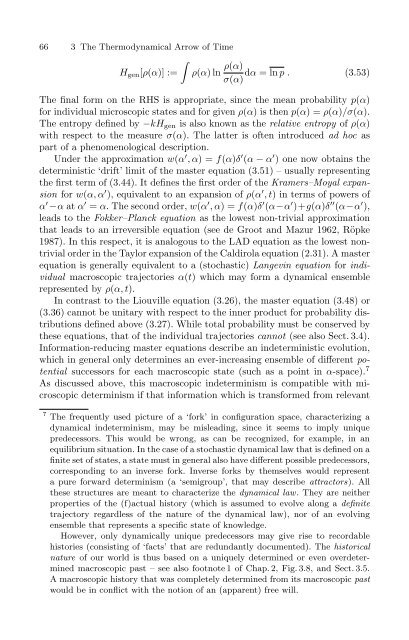The Physical Basis of The Direction of Time (The Frontiers ...
The Physical Basis of The Direction of Time (The Frontiers ...
The Physical Basis of The Direction of Time (The Frontiers ...
You also want an ePaper? Increase the reach of your titles
YUMPU automatically turns print PDFs into web optimized ePapers that Google loves.
66 3 <strong>The</strong> <strong>The</strong>rmodynamical Arrow <strong>of</strong> <strong>Time</strong><br />
∫<br />
H gen [ρ(α)] := ρ(α)ln ρ(α) dα = ln p. (3.53)<br />
σ(α)<br />
<strong>The</strong> final form on the RHS is appropriate, since the mean probability p(α)<br />
for individual microscopic states and for given ρ(α) isthenp(α) =ρ(α)/σ(α).<br />
<strong>The</strong> entropy defined by −kH gen is also known as the relative entropy <strong>of</strong> ρ(α)<br />
with respect to the measure σ(α). <strong>The</strong> latter is <strong>of</strong>ten introduced ad hoc as<br />
part <strong>of</strong> a phenomenological description.<br />
Under the approximation w(α ′ ,α)=f(α)δ ′ (α − α ′ ) one now obtains the<br />
deterministic ‘drift’ limit <strong>of</strong> the master equation (3.51) – usually representing<br />
the first term <strong>of</strong> (3.44). It defines the first order <strong>of</strong> the Kramers–Moyal expansion<br />
for w(α, α ′ ), equivalent to an expansion <strong>of</strong> ρ(α ′ ,t) in terms <strong>of</strong> powers <strong>of</strong><br />
α ′ −α at α ′ = α. <strong>The</strong> second order, w(α ′ ,α)=f(α)δ ′ (α−α ′ )+g(α)δ ′′ (α−α ′ ),<br />
leads to the Fokker–Planck equation as the lowest non-trivial approximation<br />
that leads to an irreversible equation (see de Groot and Mazur 1962, Röpke<br />
1987). In this respect, it is analogous to the LAD equation as the lowest nontrivial<br />
order in the Taylor expansion <strong>of</strong> the Caldirola equation (2.31). A master<br />
equation is generally equivalent to a (stochastic) Langevin equation for individual<br />
macroscopic trajectories α(t) which may form a dynamical ensemble<br />
represented by ρ(α, t).<br />
In contrast to the Liouville equation (3.26), the master equation (3.48) or<br />
(3.36) cannot be unitary with respect to the inner product for probability distributions<br />
defined above (3.27). While total probability must be conserved by<br />
these equations, that <strong>of</strong> the individual trajectories cannot (see also Sect. 3.4).<br />
Information-reducing master equations describe an indeterministic evolution,<br />
which in general only determines an ever-increasing ensemble <strong>of</strong> different potential<br />
successors for each macroscopic state (such as a point in α-space). 7<br />
As discussed above, this macroscopic indeterminism is compatible with microscopic<br />
determinism if that information which is transformed from relevant<br />
7 <strong>The</strong> frequently used picture <strong>of</strong> a ‘fork’ in configuration space, characterizing a<br />
dynamical indeterminism, may be misleading, since it seems to imply unique<br />
predecessors. This would be wrong, as can be recognized, for example, in an<br />
equilibrium situation. In the case <strong>of</strong> a stochastic dynamical law that is defined on a<br />
finite set <strong>of</strong> states, a state must in general also have different possible predecessors,<br />
corresponding to an inverse fork. Inverse forks by themselves would represent<br />
a pure forward determinism (a ‘semigroup’, that may describe attractors). All<br />
these structures are meant to characterize the dynamical law. <strong>The</strong>y are neither<br />
properties <strong>of</strong> the (f)actual history (which is assumed to evolve along a definite<br />
trajectory regardless <strong>of</strong> the nature <strong>of</strong> the dynamical law), nor <strong>of</strong> an evolving<br />
ensemble that represents a specific state <strong>of</strong> knowledge.<br />
However, only dynamically unique predecessors may give rise to recordable<br />
histories (consisting <strong>of</strong> ‘facts’ that are redundantly documented). <strong>The</strong> historical<br />
nature <strong>of</strong> our world is thus based on a uniquely determined or even overdetermined<br />
macroscopic past – see also footnote 1 <strong>of</strong> Chap. 2, Fig. 3.8, and Sect. 3.5.<br />
A macroscopic history that was completely determined from its macroscopic past<br />
would be in conflict with the notion <strong>of</strong> an (apparent) free will.



![arXiv:1001.0993v1 [hep-ph] 6 Jan 2010](https://img.yumpu.com/51282177/1/190x245/arxiv10010993v1-hep-ph-6-jan-2010.jpg?quality=85)


![arXiv:1008.3907v2 [astro-ph.CO] 1 Nov 2011](https://img.yumpu.com/48909562/1/190x245/arxiv10083907v2-astro-phco-1-nov-2011.jpg?quality=85)








![arXiv:1002.4928v1 [gr-qc] 26 Feb 2010](https://img.yumpu.com/41209516/1/190x245/arxiv10024928v1-gr-qc-26-feb-2010.jpg?quality=85)
![arXiv:1206.2653v1 [astro-ph.CO] 12 Jun 2012](https://img.yumpu.com/39510078/1/190x245/arxiv12062653v1-astro-phco-12-jun-2012.jpg?quality=85)
